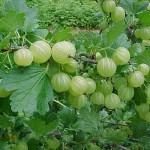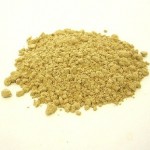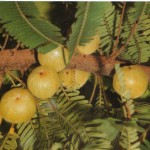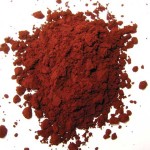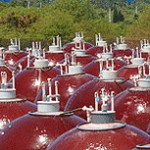|
|
|
Amla (or Amlaka or Amlaki) is one of the most frequently used ancient Ayurvedic medicines to treat a variety of disorders related to the digestive system, the lungs, metabolism, bleeding and even aging. Most sites that sell Amla products describe the fruit’s rich content of vitamin C, (“The fruit contains the highest amount of Vitamin C in natural form “) which is often said to be responsible for several of the therapeutic actions of the fruit. They are wrong and have not really done their research and are just repeating (or copying verbatim) incorrect information that was put out almost 50 years ago. In fact, it has been shown that Amla does not contain any significant amount of vitamin C, but instead other organic acids (such as malic acid and mucic acid) and various common tannoids (small tannin-like molecules) and some unique tannins, one or more of which were mistaken for vitamin C in the initial tests conducted more than 50 years ago. Even so, at the levels described (at about 0.5-0.7% of the fruit pulp), the amount of vitamin C consumed would be small by modern standards. The dominant active constituent of Amla is a group of tannins derived from gallic and ellagic acids, which make up a large portion of the extractable constituents and from other polyphenols. The fruit also contains flavonoids and kaempferol. The presence of a large proportion of tannins, the other polyphenols and flavanoids in the fruit easily explains many of the reported benefits of Amla, including treatment of respiratory and intestinal disorders, particularly intestinal ulcerations. In addition, polyphenols have been shown to have numerous health protective benefits, including lowering blood lipids and blood sugar, enhancing blood circulation, and blocking the action of carcinogens, which together contribute to the antiaging effect. The apparent superior effect of the mistaken “vitamin C” component is actually the more stable and potent anti-oxidant effect of the tannins, the other polyphenols and flavanoids in the Amla. A compilation of applications for emblica fruits was carried out by several Ayurvedic writers during the last 25 years. The main applications are for: * Digestive system disorders: dyspepsia, gastritis, hyperacidity, constipation, colic, colitis, hemorrhoids Amla has recently undergone preliminary scientific research, demonstrating invitro antiviral and antimicrobial properties. Experimental preparations have shown potential efficacy against laboratory models of disease, such as for inflammation, cancer, age-related renal disease, and diabetes. A human pilot study demonstrated reduction of blood cholesterol levels in both normal and hypercholesterolemic men. Amla is also a very fibrous fruit and these fibers are captured in Organic Amla powder. How to use Organic Amla Powder Organic Amla Powder (which has a somewhat spicy taste) blends well with soups, salads, sauces, gravies, meat and vegetable pies, rices, pastas, flours, spicy foods, pasta shell fillings and can be added to a variety of recipes. 2 tsps per day is the suggested use of the powder. About the Amla Fruit The Amla is the fruit of Phyllanthus emblica, also called Emblica officinalis. The plant, a member of the Euphorbiaceae, grows to become a medium-sized tree that is found growing in the plains and sub-mountain regions all over the Indian subcontinent from sea level to the foothills of the Himalayan mountains. The fruit is similar in appearance to the common gooseberry (Ribes spp., a type of currant), which is botanically unrelated to Amla. However, due to the similar appearance of the fruit clusters, Amla is usually called the “Indian gooseberry.” |
Astaxanthin
Astaxanthin is produced by microscopic small plants: the micro-alga Haematococcus pluvialis. Haematococcus algae can contain up to 30 g of astaxanthin per kg dried algae. These micro-alga are eaten by marine animals including fish, crawfish, crabs and lobster. The Astaxanthin is responsible for the red colour of these animals. Another commercial source is from the ink coloured yeast Xanthophyllomyces dendrorhous.
Health Benefits of Astaxanthin
Astaxanthin is a powerful antioxidant – possibly 50 times stronger than vitamin C. The free radical scavenging activity of astaxanthin protects lipids from peroxidation and reduces oxidative damage of LDL-cholesterol (thereby reducing arterial plaque formation), cells, cell membranes, mitochondrial membranes. Astaxanthin increases strength and endurance.
Astaxanthin seems to improve the immune system by increasing the number of antibody producing cells. Astaxanthin enhances antibody production by exerting actions on T-cells and T-helper cells. Astaxanthin is used to treat neurodegenerative conditions such as Alzheimer’s and Parkinson?s disease.
Astaxanthin protects the eyes and skin from sun radiation damage by quenching singlet and triplet oxygen. Studies with rats show that astaxanthin reduces retinal injury.
Studies have shown the anti-cancer effects of astaxanthin in rodents. The inhibitory effect of astaxanthin on cancer is stronger han that of beta-carotene.
Facts about Astaxanthin
Most Astaxanthin is not extracted from the marine plants but is chemically produced. In commercial fish and crustacean farms, chemically produced astaxanthin is added to feeds in order to improve the colour.
RDA 10 mg.
Astaxanthin, unlike some carotenoids, does not convert to Vitamin A (retinol) in the human body. Too much Vitamin A is toxic for a human, but astaxanthin is not. While astaxanthin is a natural nutritional component, it can be found as a food supplement. The supplement is intended for human, animal, and aquaculture consumption. Astaxanthin has 100-500 times the antioxidant capacity of Vitamin E and 10 times the antioxidant capacity of beta-carotene. Many laboratory studies also indicate Astaxanthin is a stronger antioxidant than lutein, lycopene and tocotrienols. Currently, the primary use for humans is as a food supplement. Research shows that due to astaxanthin’s potent antioxidant activity, it may be beneficial in cardiovascular, immune, inflammatory and neurodegenerative diseases. Research supports the assumption that it protects body tissues from oxidative damage
References
Superorganicfoods.com
http://en.wikipedia.org/wiki/Astaxanthin
http://www.nationmaster.com/encyclopedia/E161j Back to top
